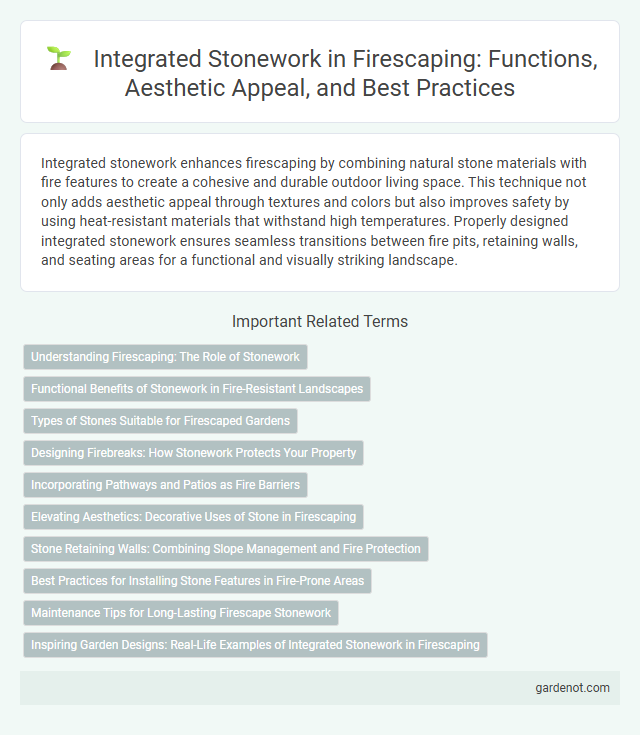Integrated stonework enhances firescaping by combining natural stone materials with fire features to create a cohesive and durable outdoor living space. This technique not only adds aesthetic appeal through textures and colors but also improves safety by using heat-resistant materials that withstand high temperatures. Properly designed integrated stonework ensures seamless transitions between fire pits, retaining walls, and seating areas for a functional and visually striking landscape.
Understanding Firescaping: The Role of Stonework
Integrated stonework plays a crucial role in firescaping by providing durable, heat-resistant surfaces that enhance both safety and aesthetics around fire features. Using natural or manufactured stone, designers create functional elements such as fire pit surrounds, retaining walls, and seating areas that seamlessly blend with the landscape. Properly installed stonework ensures structural integrity while minimizing fire hazards, making it a key component in effective firescaping design.
Functional Benefits of Stonework in Fire-Resistant Landscapes
Integrated stonework in fire-resistant landscapes enhances safety by serving as natural firebreaks that slow or stop the spread of flames. Stone materials resist heat and do not ignite, protecting surrounding plants and structures while reducing fuel load. These durable surfaces also improve accessibility for firefighting efforts and maintenance during high-risk fire conditions.
Types of Stones Suitable for Firescaped Gardens
Granite, limestone, and sandstone are highly suitable stones for firescaped gardens due to their durability and heat resistance. Granite's dense composition withstands high temperatures and weathering, making it ideal for fire pits and surrounding features. Sandstone offers natural aesthetic appeal and absorbs heat well, while limestone provides a softer texture that complements fire elements without cracking under thermal stress.
Designing Firebreaks: How Stonework Protects Your Property
Integrated stonework acts as an effective firebreak by creating non-combustible barriers that inhibit the spread of wildfires across a property. Strategically placed stone patios, retaining walls, and pathways reduce fuel continuity, lowering the risk of fire damage to landscaping and structures. Utilizing local stone with fire-resistant properties enhances the overall resilience of your firescape design while maintaining aesthetic appeal.
Incorporating Pathways and Patios as Fire Barriers
In firescaping, integrating stonework by incorporating pathways and patios serves as an effective fire barrier by creating non-combustible zones that inhibit the spread of flames near structures. Using materials like flagstone, pavers, or crushed stone ensures durability and heat resistance while enhancing landscape aesthetics. Properly designed stone pathways and patios also facilitate safe access for emergency responders during wildfire events.
Elevating Aesthetics: Decorative Uses of Stone in Firescaping
Integrated stonework enhances firescaping by creating visually striking and durable outdoor fireplaces, fire pits, and seating areas that seamlessly blend with natural surroundings. Using materials such as granite, limestone, and slate adds texture and color variations, elevating the overall aesthetic appeal while ensuring heat resistance and longevity. Decorative stone accents, including veneer and carved details, provide custom design elements that complement landscaping themes and increase property value.
Stone Retaining Walls: Combining Slope Management and Fire Protection
Stone retaining walls provide effective slope stabilization by preventing soil erosion and managing water runoff, crucial in fire-prone landscapes. Their dense, non-combustible materials act as fire barriers, reducing wildfire spread and protecting structures downslope. Integrating these walls into firescaping designs enhances landscape resilience while preserving natural aesthetics and functional grade control.
Best Practices for Installing Stone Features in Fire-Prone Areas
Integrated stonework in fire-prone areas requires the use of non-combustible materials such as natural stone or fire-resistant manufactured stone to create durable, safe fire features. Proper installation involves securing stone elements with heat-resistant mortar and ensuring sufficient clearance from flammable vegetation to prevent fire spread. Incorporating fire-resistant barriers and maintaining regular inspections also enhance the longevity and safety of stone features in vulnerable landscapes.
Maintenance Tips for Long-Lasting Firescape Stonework
Regularly clean integrated stonework with a mild detergent and water to prevent dirt buildup and staining, preserving the natural texture and color of the firescape. Apply a high-quality stone sealer every 1-2 years to protect against moisture penetration, freeze-thaw damage, and surface erosion. Inspect joints and grout for cracks or deterioration, repairing them promptly to maintain structural integrity and prolong the lifespan of the stonework.
Inspiring Garden Designs: Real-Life Examples of Integrated Stonework in Firescaping
Integrated stonework in firescaping transforms outdoor spaces by seamlessly blending fire features with natural elements, enhancing both functionality and aesthetics. Examples include fire pits encircled by custom-cut flagstone seating and retaining walls crafted from locally sourced stone that complement the garden's native flora. These designs create cohesive, inviting environments that balance warmth, texture, and durability for year-round outdoor enjoyment.
Integrated stonework Infographic

 gardenot.com
gardenot.com